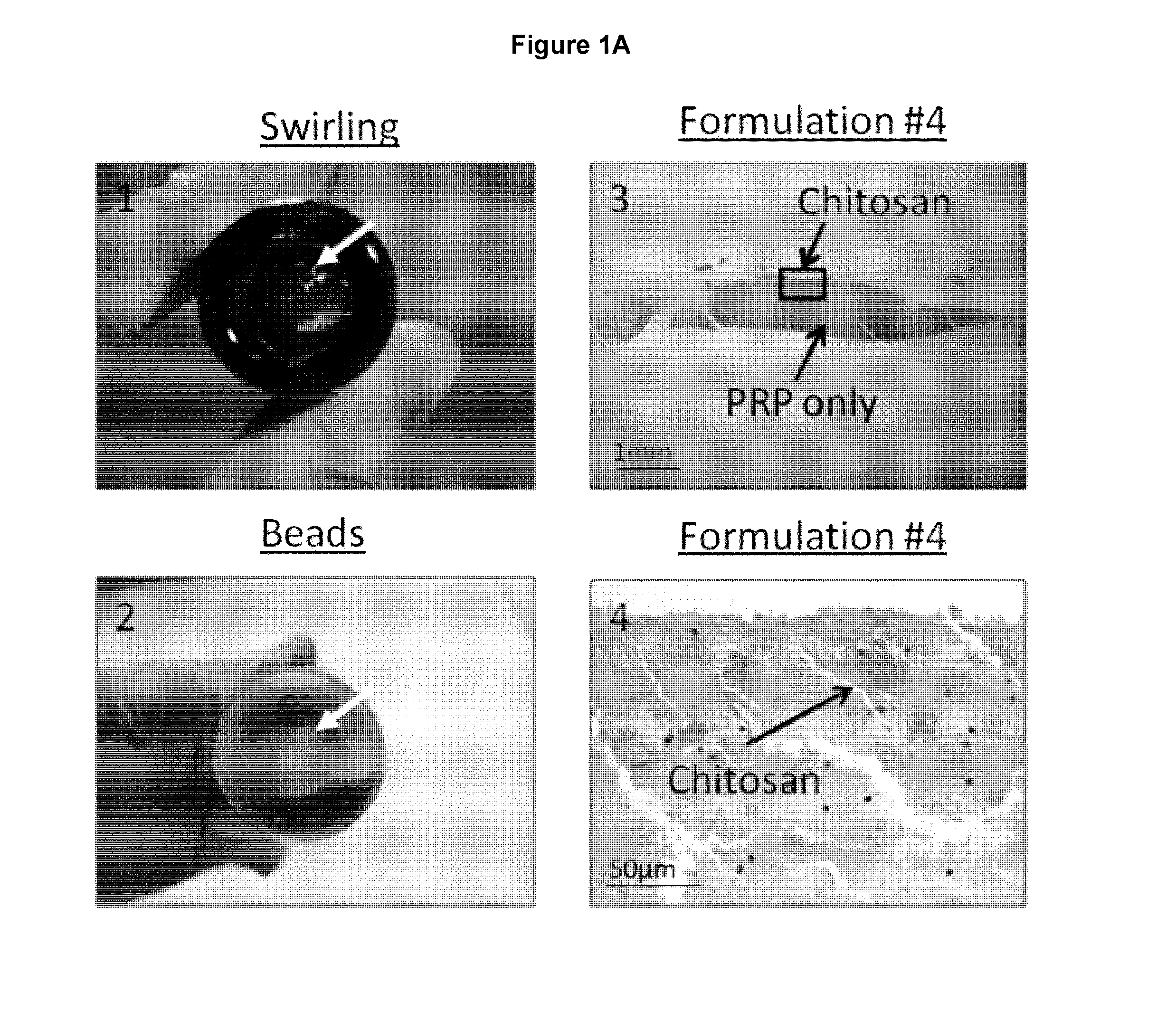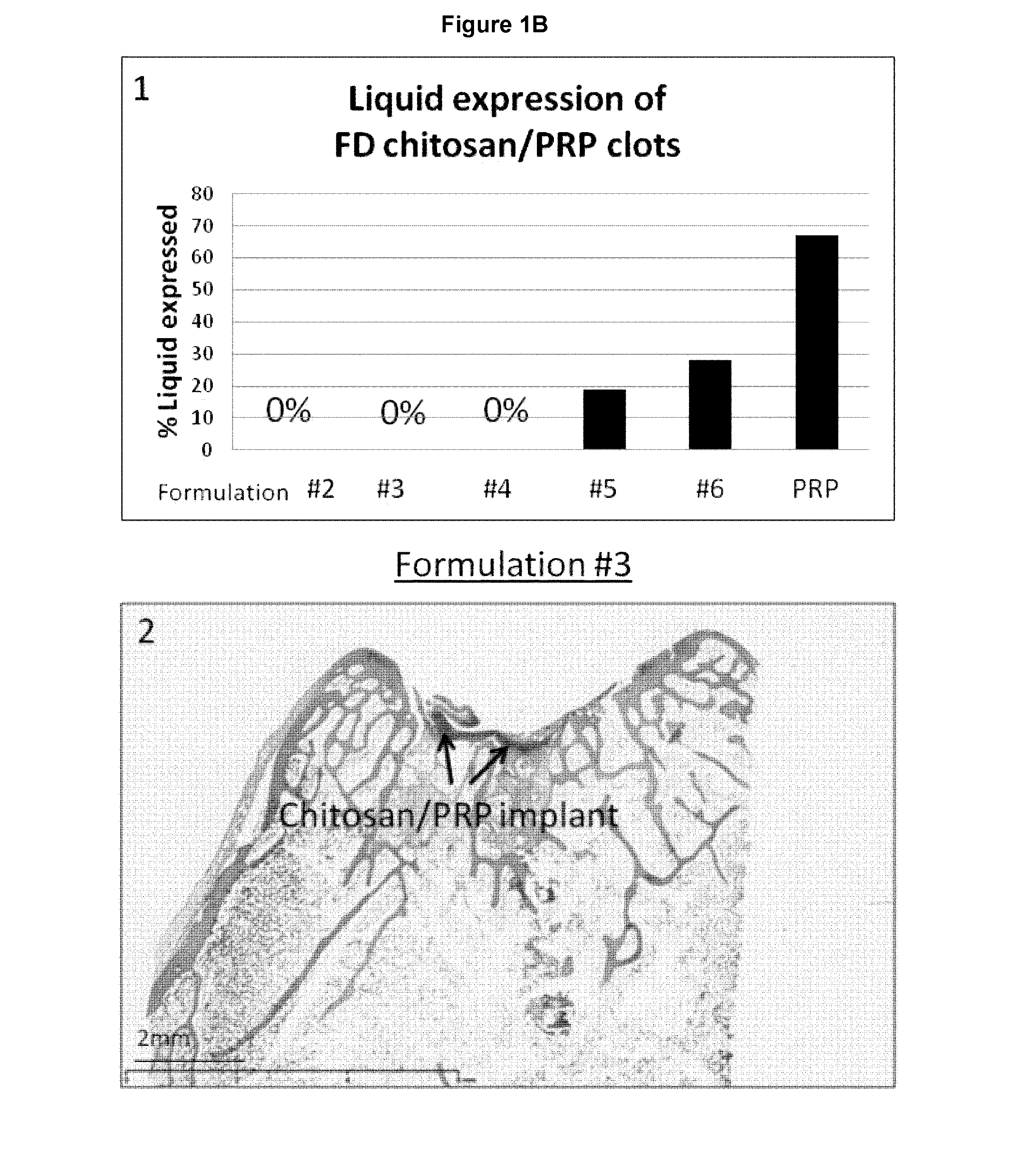Freeze-dried polymer compositions for mixing with platelet rich plasma to form implants for tissue repair and/or compositions for therapeutic intra-articular injections
a technology of platelet rich plasma and compositions, which is applied in the field of freeze-dried polymer compositions for mixing with platelet rich plasma to form tissue implants, can solve the problems of not being able to achieve physiological, viable, and not being able to improve the healing of the medial femoral condyle of immature patients, and achieve the effect of modulating healing mechanisms and improving repair
- Summary
- Abstract
- Description
- Claims
- Application Information
AI Technical Summary
Benefits of technology
Problems solved by technology
Method used
Image
Examples
example 1
1—Preparation of Chitosan Formulations
[0109]Formulations without lyoprotectants or buffer: Chitosan weight average molecular weight Mw 500 kDa, measured by GPC as described in [Nguyen, S., F. M. Winnik, and M. D. Buschmann, Improved reproducibility in the determination of the molecular weight of chitosan by analytical size exclusion chromatography. Carbohydrate Polymers, 2009. 75(3): p. 528-533], and 80.6% DDA was dissolved in HCl overnight at room temperature to obtain a final chitosan concentration of 0.56% or 0.67% (w / v). The solutions were autoclaved for 10 minutes and cooled on ice. Post-autoclave chitosan Mw was between 319-403 kDa. Autoclaved 5M NaCl and filter-sterilised 270 mM CaCl2 were added as required before dispensing in 10 mL individual vials for freeze-drying.
[0110]Formulations with lyoprotectants and buffer: Chitosan (Mw 500 kDa, 80.6% DDA) was dissolved in HCl overnight at room temperature to obtain a final chitosan concentration of 0.56% or 0.67% (w / v). Autoclaved...
example 2
1—Preparation of Chitosan Formulations
[0134]Chitosan number average molecular weight Mn 211 kDa, measured by GPC as described in [Nguyen, S., F. M. Winnik, and M. D. Buschmann, Improved reproducibility in the determination of the molecular weight of chitosan by analytical size exclusion chromatography. Carbohydrate Polymers, 2009. 75 (3): p. 528-533] and 80.6% DDA was dissolved in HCl overnight at room temperature to obtain a final chitosan concentration of 0.56% or 0.42% (w / v). The solutions were autoclaved for 10 minutes and cooled on ice. Post-autoclave chitosan Mn was between 112-160 kDa. Autoclaved 20% (w / v) sucrose, 20% (w / v) trehalose and 5M NaCl as well as filter-sterilised 270 mM CaCl2 and were added, as required. A filter-sterilised Rhodamine-chitosan tracer (Mn 143 kDa, 80.0% DDA) was added before dispensing in 10 mL individual vials for freeze-drying.
[0135]As per Table 4, the HCl concentration was adjusted so that all formulations had theoretical target pH 6.45. The NaCl...
example 3
1—Preparation of Chitosan Formulations
[0156]Chitosan (Mn 211 kDa, 80.6% DDA) was dissolved in HCl overnight at room temperature to obtain a final chitosan concentration of 0.56% (w / v). The solutions were autoclaved for 10 minutes and cooled on ice. Post-autoclave chitosan Mn was 151 and 162 kDa. Autoclaved 20% (w / v) trehalose and 5M NaCl, as well as filter-sterilised 270 mM CaCl2 and were added, as required. Filter-sterilised Rhodamine-chitosan tracer (Mn 143 kDa, 80.0% DDA) was added before dispensing in 10 mL individual vials for freeze-drying.
[0157]As per Table 6, the HCl concentration was adjusted so that all formulations had theoretical target pH 6.45. The NaCl concentration was adjusted so that the formulation had theoretical osmolality 350 mOsm. Lyoprotectant concentration was set at 2% (w / v) for formulation #2.
[0158]The freeze-drying cycle was identical to the one described in Example 2, Section 2-Freeze-drying cycle.
TABLE 6Freeze-dried formulations containing the clot activ...
PUM
| Property | Measurement | Unit |
|---|---|---|
| Fraction | aaaaa | aaaaa |
| Fraction | aaaaa | aaaaa |
| Fraction | aaaaa | aaaaa |
Abstract
Description
Claims
Application Information
 Login to View More
Login to View More - R&D
- Intellectual Property
- Life Sciences
- Materials
- Tech Scout
- Unparalleled Data Quality
- Higher Quality Content
- 60% Fewer Hallucinations
Browse by: Latest US Patents, China's latest patents, Technical Efficacy Thesaurus, Application Domain, Technology Topic, Popular Technical Reports.
© 2025 PatSnap. All rights reserved.Legal|Privacy policy|Modern Slavery Act Transparency Statement|Sitemap|About US| Contact US: help@patsnap.com



